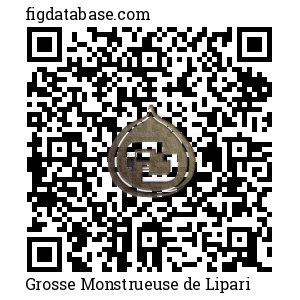This site contains affiliate links for which I may be compensated.
Grosse Monstrueuse de Lipari
Grosse Monstrueuse de Lipari Information


-
Possible Synonyms / AKA:
DFIC 67, Grosse de Monstrueuse de Lipari, Monstrueuse, Monstreuse de Lipari, P.I. No. 18,846, PI 18846, P.I. No. 18,878, PI 18878, -
Introduced By:
-
Origin:
-
Main Flavor Group:
Adriatic - delivers a balanced sweetness with a refreshing, light flavor. It combines subtle berry-like notes. Yellow or green skin and usually red pulp, with more complex additional flavors developing when fully ripe. -
Family Group:
-
Fig Type:
Common - Self fertile and will grow anywhere conditions are suitable -
Cold Hardy:
N/A -
Container Variety:
N/A -
Easy Rooting:
N/A -
Main Season:
any -
Availability:
N/A -
Breba Crop:
Yes -
Seed Crunch:
N/A -
Eye:
N/A -
Skin Toughness:
N/A -
Fruit Size:
Medium to large -
Rain Resistance:
N/A -
Tree Vigor:
N/A -
External Links:
https://m.youtube.com/watch?v=2B_pc7cQKKo&feature=youtu.be
https://npgsweb.ars-grin.gov/gringlobal/accessiondetail.aspx?1002022
https://youtu.be/Q2yNp0NN5GA
https://www.ourfigs.com/forum/variety-test/4094-monstrueuse
https://youtu.be/afEIhjSq1zc
Description
From Harvey (Figaholics):
Reported to be an Italian variety which has been grown in California by fig collectors and USDA for several years though a grower in Sicily reported in 2015 that it is mislabeled. Fruits he showed are much larger. Regardless, this has been a popular fig as it's productive and fruits are sweet and very flavorful. Note: some spellings of this have varied on my pages and elsewhere, but we're now going with spelling shown in Condit's publication.
Condit Monograph
As Monstrueuse: (syn. Grosse Monstrueuse DE Lipari). Described by Barron (1868c, 1870, 1891), Hogg (1871; with figure), and Eisen (1888, 1901). Illustrated by Barron (1870) from fruits produced at Chiswick; he reported it as Grosse Monstrueuse DE Lipari, a French variety, comparatively Unknown in England. P.I. No. 18,846 of the Chiswick collection has fruited in several test orchards under the name of Monstrueuse. Doubt has existed as to the identity of this variety, which, according to Barron, has a light- brown or chestnut-colored skin in England, while California specimens are green in color. This discrepancy can be explained by the fact that Barron's account is of the brebas only, which in California have a general green color but are commonly flushed with violet from the underlying colored meat. P.I. No. 18,878, labeled Dr. Hogg's Clare, is the same as Monstrueuse. In England it is essentially a ''first-bearing'' kind, and rarely yields a second crop.
Cuttings from five different gardens in Washington, D.C., have produced fruit identical with that of Monstrueuse in test plots in California, demonstrating the fact that this variety is being successfully grown in the eastern United States. At Riverside, California, the Breba crop is exceptionally good. Second-crop figs are larger and better in the coastal district of Los Angeles than at Riverside, as pointed out by Condit (1950). Apparently Monstrueuse was not tested at the early California Experiment Stations, and only recently have its good qualities recommended it for trial as a dooryard fruit.
The tree is vigorous, with broad, dense top; terminal buds are green. Leaves medium to large, somewhat glossy above, 3- to 5-lobed, the former predominating; upper sinuses shallow; base cordate; margins crenate.
Brebas above medium to large, oblique-pyriform, mostly with distinct, thick neck; average weight 47 grams; stalk thick, up to 1/2 inch long; eye medium, open, scales straw color, or tinged with pink; white flecks scattered, prominent; color green, tinged with violet from the underlying meat; pulp dark strawberry, with a characteristic fig flavor; quality good. (Plate 19, A.)
Second-crop figs medium or above, up to 2-1/2 inches long and 2 inches in diameter, turbinate, without neck, or with short, thick neck; average weight 40 grams; stalk up to 5/8 inch long; white flecks large and scattered; ribs narrow, very slightly raised, showing partly as thin lines of dark green; eye medium, open, scales tawny, erect; color grass green; pulp very light strawberry, solid, or slightly hollow at center; flavor sweet, rich; quality good.
Caprified figs somewhat larger, inclined to split at apex; pulp dark strawberry; seeds numerous. (Plate 19, B.)
Other Comments
Condit praises it highly. Large, grass-green fig of good quality. Fairly tender. Medium-large, green tinged with violet figs have dark strawberry colored pulp. Very good quality, rich and sweet. Vigorous and productive tree produces both a Breba and second crop. A French variety dating from the mid 1800's it is known to do well in the eastern US.
Ray Givens: An excellent fig with an unfortunate name. Leaf: cordate, 3 to 5 lobes, upper sinuses shallow, crenate margins. Two crops. Brebas are oblique-pyriform with large, distinct neck, medium to large, green tinged with violet and dark strawberry pulp. Good quality. Main crop figs are slightly smaller, turbinate without neck or with a short one, grass green with light pink pulp. Sweet and rich flavor. Quality and size varies according to local climate. Brebas, for example, are good at Riverside while the Main crop is bigger and better on the California coast. I have been looking for this one for five or six years and finally got a couple of plants from some cuttings Don Polensky of San Jose, California sent me in early January 1998. Synonym:
Main crop figs are rich in flavor, dark red pulp with green skin. Breba crop sampled in 2014 was not very good. I neglected eating this fig for several years due to thinking green figs just aren't right but then realized how good this fig was and it's reliably a great fig although sometimes it's soured on me, but usually way past peak ripeness.
As Monstrueuse: (syn. Grosse Monstrueuse DE Lipari). Described by Barron (1868c, 1870, 1891), Hogg (1871; with figure), and Eisen (1888, 1901). Illustrated by Barron (1870) from fruits produced at Chiswick; he reported it as Grosse Monstrueuse DE Lipari, a French variety, comparatively Unknown in England. P.I. No. 18,846 of the Chiswick collection has fruited in several test orchards under the name of Monstrueuse. Doubt has existed as to the identity of this variety, which, according to Barron, has a light- brown or chestnut-colored skin in England, while California specimens are green in color. This discrepancy can be explained by the fact that Barron's account is of the brebas only, which in California have a general green color but are commonly flushed with violet from the underlying colored meat. P.I. No. 18,878, labeled Dr. Hogg's Clare, is the same as Monstrueuse. In England it is essentially a ''first-bearing'' kind, and rarely yields a second crop.
Cuttings from five different gardens in Washington, D.C., have produced fruit identical with that of Monstrueuse in test plots in California, demonstrating the fact that this variety is being successfully grown in the eastern United States. At Riverside, California, the Breba crop is exceptionally good. Second-crop figs are larger and better in the coastal district of Los Angeles than at Riverside, as pointed out by Condit (1950). Apparently Monstrueuse was not tested at the early California Experiment Stations, and only recently have its good qualities recommended it for trial as a dooryard fruit.
The tree is vigorous, with broad, dense top; terminal buds are green. Leaves medium to large, somewhat glossy above, 3- to 5-lobed, the former predominating; upper sinuses shallow; base cordate; margins crenate.
Brebas above medium to large, oblique-pyriform, mostly with distinct, thick neck; average weight 47 grams; stalk thick, up to 1/2 inch long; eye medium, open, scales straw color, or tinged with pink; white flecks scattered, prominent; color green, tinged with violet from the underlying meat; pulp dark strawberry, with a characteristic fig flavor; quality good. (Plate 19, A.)
Second-crop figs medium or above, up to 2-1/2 inches long and 2 inches in diameter, turbinate, without neck, or with short, thick neck; average weight 40 grams; stalk up to 5/8 inch long; white flecks large and scattered; ribs narrow, very slightly raised, showing partly as thin lines of dark green; eye medium, open, scales tawny, erect; color grass green; pulp very light strawberry, solid, or slightly hollow at center; flavor sweet, rich; quality good.
Caprified figs somewhat larger, inclined to split at apex; pulp dark strawberry; seeds numerous. (Plate 19, B.)
Other Comments
Condit praises it highly. Large, grass-green fig of good quality. Fairly tender. Medium-large, green tinged with violet figs have dark strawberry colored pulp. Very good quality, rich and sweet. Vigorous and productive tree produces both a Breba and second crop. A French variety dating from the mid 1800's it is known to do well in the eastern US.
Ray Givens: An excellent fig with an unfortunate name. Leaf: cordate, 3 to 5 lobes, upper sinuses shallow, crenate margins. Two crops. Brebas are oblique-pyriform with large, distinct neck, medium to large, green tinged with violet and dark strawberry pulp. Good quality. Main crop figs are slightly smaller, turbinate without neck or with a short one, grass green with light pink pulp. Sweet and rich flavor. Quality and size varies according to local climate. Brebas, for example, are good at Riverside while the Main crop is bigger and better on the California coast. I have been looking for this one for five or six years and finally got a couple of plants from some cuttings Don Polensky of San Jose, California sent me in early January 1998. Synonym:
Main crop figs are rich in flavor, dark red pulp with green skin. Breba crop sampled in 2014 was not very good. I neglected eating this fig for several years due to thinking green figs just aren't right but then realized how good this fig was and it's reliably a great fig although sometimes it's soured on me, but usually way past peak ripeness.
If you'd like your banner to be shown here and throughout Fig Database, send us a message.
Photos Add Your Image
No Images Found
YouTube Videos
No Videos Found






